Wexford for History Lovers
Planning a trip to County Wexford and intrigued by its history and story through time?
Stay with us as we travel through time and bring you a compilation of Irish history that tells the tale of our wealthy culture and rich history here in the corner of Ireland’s Ancient East as you #KeepDiscovering
Our #TravelTuesday Tip: To ensure you indulge in your trip and get the most out of it, ensure you plan it down to a T. If you’re planning to spend a day down a wormhole of history and make a day of it by discovering and exploring Wexford’s historical and cultural heritage, be sure to hit the best spots in a convenient order to ensure you’re not wasting travel time and making the most of your visit to your most desired historic sites.
So, throw the history books to one side, sit back and let us give you a brief rundown of the history of Wexford to ensure you’re ready before hitting the Model County.
Wexford Town was founded in 800 AD by the Vikings and by 1169, it became surrendered by the Normans. The name ‘Wexford’ came from the meaning ‘inlet of flat mud lands’, which in Scandinavian terms, was pronounced as ‘Waesfjord.’ On the contrary, it is said that the Irish meaning for Wexford which is ‘Loch Garman,’ came from a tale which saw a local Wexford man called Garman Garbh, drown on the mud flats of the River Slaney, and the flood waters were released by an enchantress. Furthermore, the lake was named Lake of Garman.
From Vikings, castles, abbeys and historical events, to Wexford’s famous scene in Saving Private Ryan, the opera festival and much more, there’s no doubt that every corner of County Wexford has some historical traction that drives more and more to love Wexford and it’s heritage.
Vikings and their stamp on Wexford
County Wexford was one of the area’s invaded by Vikings in the 8th century due to its place on coastal land which meant it was the ideal place to loot Christian monasteries and establish bases in Ireland. 819AD was when the raid first took place on the North Slob area of Wexford harbour and after than, both the native Irish people and the Norse newcomers, began to interlink as one and they finally accepted Christianity, which has a major role in the layout of Wexford’s many small villages and parishes being built in one area during medieval times.
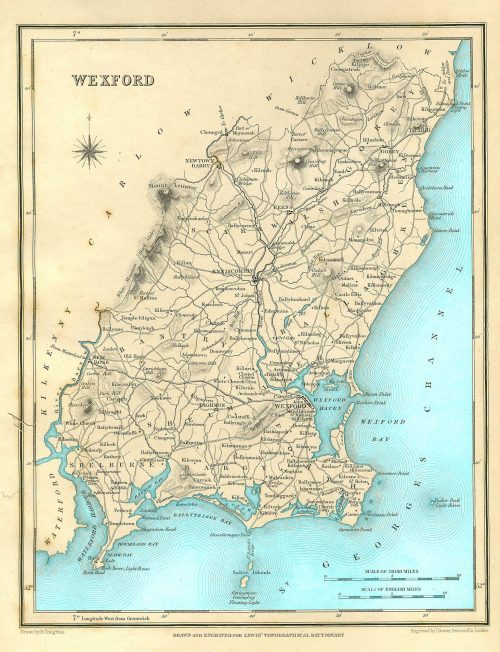
Each parish was extremely close-knit, hence the closeness between St. Patrick’s Church, St. Mary’s Church and St. Peter’s Church in Wexford Town. It can also be seen throughout the many narrow streets and small lanes that situate themselves across Wexford Town.On another note, Wexford Town was also so commonly invaded and raided by the Normans due to its location and proximity to many shipping routes in the Irish Sea.
After the Norman invasion, the town of Wexford surrendered and land was divided between Norse men and Wexford. However, efforts to secure the region by Norm, Robert Fitz Stephen, encouraged him to build a wooden ringwork castle which can be today seen from Ferrycarrig, on the outskirts of Wexford Town, overlooking the River Slaney which was convenient for Stephen to elude eruption. This defensive ditch that was built, is interestingly visible inside the Irish National Heritage Park.
Overall, while the invasion of Normans caused stir in County Wexford, it goes without saying that they left us with much to think about when they expanded the town and left it lying under an abundance of historical sites, with monumental stories. Some of these sites conclude the Westgate Tower and Selskar Abbey.
Enniscorthy
The National 1798 Rebellion Centre
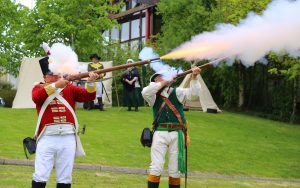
Irish history has a strong place in the story of the Emerald Isle, and the events of 1798 in Ireland are among that, after being flamed by the revolution that took place in France and America. The National 1798 Rebellion Centre is dedicated to the 1798 Rebellion, as a tribulation to the ongoings of the events that took place on Vinegar Hill at the top of Enniscorthy town. During the time, County Wexford was at the forefront of the 1798 rebellion against the English rule which saw the massacre of local loyalists held by the rebels, executed on the bridge in the centre of Enniscorthy.
Visit The National 1798 Rebellion Centre to endeavour on a journey of ‘what was,’ meeting key men that became strong figures in the 1798 Rebellion. Learn about the weapons used from that period, as well as exploring Enniscorthy and Vinegar Hill with 4D art of the Vinegar Hill Experience, along with much more.
Check out more about The National 1978 Rebellion Centre
Vinegar Hill
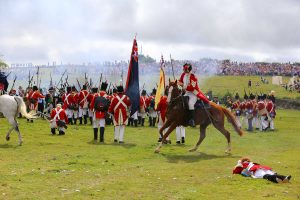
Overlooking the historical town of Enniscorthy, and as the famous site that endeavoured the Battle of the Hill during the 1798 Rebellion, the hill remains intact to some extent, with breathtaking views over the town of Inis Cortaigh (Irish for Enniscorthy) and its hinterlands. As the most famous site of the rebellion, the hill saw 20,000 rebel men, women and children face a total of 10,000 crown forces battle to defend the ground beneath King George lll’s army and the crown forces. The 21st of June 1798 saw 1,500 die after the four hour battle. It was a turning point in the Irish Rebellion of 1798, and at that, the most successful and uprising that County Wexford, and respectively Enniscorthy, encountered.
Visit The National 1798 Centre and participate in the 4D Battle of Vinegar Hill Experience, as well as meeting the key figures of the Rebellion.
Check out more about Vinegar Hill
Enniscorthy Castle
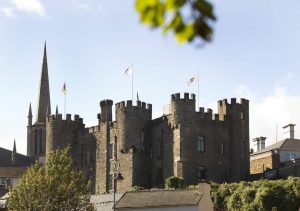
As the focal point of Enniscorthy Town, Enniscorthy Castle has intact its roots since the 13th century, with restoration and updates often happening to ensure of it’s well being as one of County Wexford’s many historic attractions. The castle now resides as a visitor attraction and experience centre which showcases an abundance of pieces from Irish history. Besides the castles rooftop views over the historical town, and its ground floor covering history from the 1600’s with many interactive exhibitions, the castle in itself has been home to Norman Knights, English armies, Irish rebels and prisoners, and local merchant families
Visit Enniscorthy Castle to discover the story behind the castle in itself, along with Enniscorthy Town during its earliest origins when the Anglo-Norman’s resided there. Behold the castle’s further exhibitions, showcasing the work of Eileen Gray who was born in 1878 and features renowned Irish furniture which dates back to that time when Gray designed the pieces. As an added bonus, visit the castle’s dungeon which features wall art of rarity which dates back to medieval times.
Check out more about Enniscorthy Castle
Oulart Hill
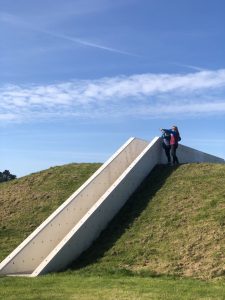
While Vinegar Hill has a significant place in the history of The National 1798 Rebellion, Oulart Hill was also a contending battlefield like many across the country at the time. Now, the hill has many a mention in various Irish traditional songs to commemorate the battle of 1798, such as the famous ballad ‘Boolavogue,’ which was written to remember the Easter Rising in 1916, where a small rebellion took place in the town of Enniscorthy.
Today, the 1798 battlefield upon Oulart Hill, is now compromised with three walking trails. History stands with the area and the atmosphere as pods with the hill’s story explained through time. There is also noticeable reasoning as to why the battle took place on the hill, with strategic significance on it’s height and panoramic views across the countryside of Wexford.
A monumental feature of the historical attraction is the Tulach a’ tSolais, which signifies the context of the European Enlightenment that was dedicated to 1798. Cosán na Glóire sides with 25 memorial stones commemorating the locals that fought in the 1798 battle on Oulart Hill, which runs across the level summit on the battlefield next to Tulach a’ tSolais. Visit both Enniscorthy Castle and The National 1798 Centre in Enniscorthy, as well as Vinegar Hill in order to join up the dots and find significance in each of the battlefields and commemorative museums dedicated to the battle of 1798.
Check out more about Oulart Hill
Wexford
Wexford Town
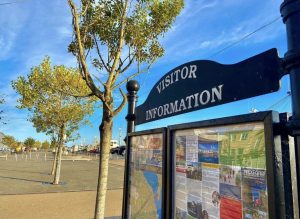
Like mentioned previously, Wexford town was situated in the most prime and strategic location for the Vikings to raid and settle in the area in the 9th century. It’s place as a town sitting in the mouth of the River Slaney and overlooking the harbour, made it a pivotal spot for those during the time to seek out enemies and intruders. As well as that, as it provided access to the River Slaney which flows through the centre of the entire county, it also provided access to various other counties like Wicklow and Carlow.
Centre to the town, the Bull Ring was a place of a cruel sport in the 1600s. The sport at the time was known as bull baiting and became outlawed by the Cruelty to Animals Act of 1835. The Bull Ring known now is surrounded by shops, restaurants and markets.
St. Iberius Church on Wexford towns Main Street is believed to have been situated on the head of a Christian site which interestingly dates back to before St. Patrick came to Ireland.
Click out more about Wexford Town
Selskar Abbey
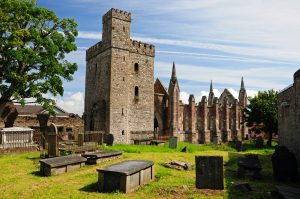
Selskar Abbey which is a part of Westgate Heritage Tower, is a 12th century structure which replaced a temple which dates back to pre-Christian times. Built on the ruins where the first Anglo-Irish peace treaty was signed by Diarmait Mac Murchada in 1169, the site remains one of the many popular tourist attractions in the county. Interestingly, Diarmait Mac Murchada was removed as the King of Leinster and caused the events that led to the Norman invasion of Ireland. 1649 saw the abbey being destroyed by Oliver Cromwell and almost two centuries later, built back up as a Protesant church in 1826.
Curracloe
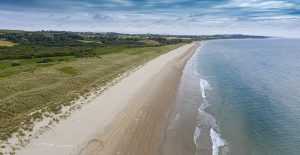
While Curracloe Beach is renowned for its place among Ireland’s top beaches for it’s beautiful 250km of coastline, it is also famous for its appearance in Steven Spielberg’s 1998 Oscar winning film “Saving Private Ryan.” The opening scenes in the movie which depicted the D-day assault on Ohama Beach were filmed over two months in 1997 and the reason Curracloe Beach was chosen for filming was because it was most similar to Ohama Beach in Normandy. It is estimated that a total of over £6 million was boosted into the Irish economy as a result.
Check out more about Curracloe beach
New Ross
Tintern Abbey
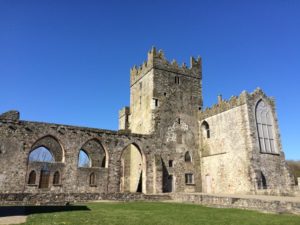
Tintern Abbey was one of the many religious houses that were dismissed by Henry VIII between 1536 and 1541. Circa 1200, the abbey was originally founded by Knight William Marshal with his impact on the south-east of Ireland a vital role. Marshal founded the Abbey for the Cistercian order in which the monks lived and worked thereafter. Over the centuries, Tintern Abbey homed knights, monks, scoundrels, lawmakers, lawbreakers, custodians and more, until the Colclough family then possessed the Abbey after the dismissal of religious houses by King Henry VIII. Now, the Abbey welcomes visitors to learn more, with rich insights into the history and beautiful views from the Colclough Library over Bannow Bay.
Check out more about Tintern Abbey
President John F. Kennedy’s relations to New Ross

Past president of the United States, John F. Kennedy’s grandfather Patrick Kennedy was born in New Ross, County Wexford which explains the 35th president’s connection to the cornerstone of Ireland’s Ancient East. In the mid 1800s, President Kennedy’s grandfather emigrated from Dunganstown, New Ross, to the United States of America and holding on to ancestral reasonsings, president John F. Kennedy visited the town of New Ross in June 1963. With such close connection and rich history behind the story, New Ross is home to many places of commemoration and memorial monuments dedicated to the president. These include the Kennedy Homestead, the Irish American Hall of Fame which holds centerpiece in the Dunbrody Famine Ship Experience, as well as the JFK Arboretum.
Dunbrody Famine Ship
One of County Wexford’s most historic attractions situated quayside to New Ross is the Dunbrody Famine Ship Experience which is an authentic reproduction of the emigrant vessel that left the town in the 1840s for the USA. The visitor centre is home to a profound amount of history tied to the famine emigrant experience which saw a great degree of sadness and allowed the visitor to gain an insight into, and interpretation of the happenings during that time.
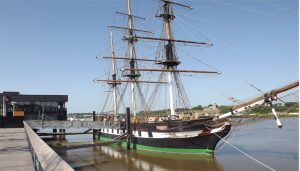
The award winning experience has given visitors a true feel of travelling back through time, with the tour initiating the moment that the ship departed in the 1840s, and set sail for a new life, leaving poverty and despair behind. It gives the visitor a true mix of emotions felt by those that set sail – from sadness and despair to excitement for a new life. Become engrossed in the sights and sounds of the famine ship that ignites the real life feel and scene of the journey ahead, one in which President John F. Kennedy’s grandfather Patrick Kennedy set sail on.
Among the themed exhibitions and guided tours, the Dunbrody Visitor Centre is also home to the Irish America Hall of Fame which commemorates the Irish men and women whom contributed to US history with President John F. Kennedy being one of many, as well as a beautiful river-view restaurant which overlooks the River Barrow. Moreover, just outside the centre shapes the incredible Emigrant Flame, as well as the John F. Kennedy memorial wall and statue in memory of the 35th president.
Check out more about The Dunbrody Famine Ship Experience
JFK Abortrum
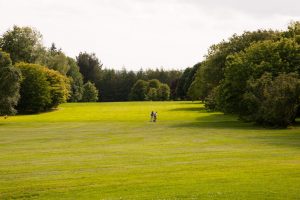
Dedicated to the memory of the 35th President of the United States of America, John F. Kennedy, the JFK Arboretum lies prominent in New Ross as one of the beautiful landscapes in the town. However, the JFK Arboretum plays an important role in Irish American history, containing a plant collection of presidential proportions. Covering 252 hectares with 4,500 types of trees and shrubs, to 200 forest plots grouped by continents, the Arboretum is certainly worth visiting. One of the most striking elements of the Arboretum is the lake which is a haven for waterfowl.
Among these beautiful wonders across the grounds are many woodland walks, a playground and treehouses, as well as a lake which is home to many ducks and fish. Guided walks of the memorial are provided by arrangement, while a miniature train and pony and trap operate during specific seasons. Nearby Slieve Coillte provides those with a watchful eye, views of six different counties.
Check out more about The JFK Abortrum
Kennedy Homestead
Kennedy Homestead is a museum and farm in New Ross, run by President John F. Kennedy’s descendants and tells the success story of the Irish in America. The visitor centre focuses on celebrating the story of the Kennedy’s five generation dynasty as the most eminent family with Irish-American heritage, to have left Ireland during the Irish Famine.
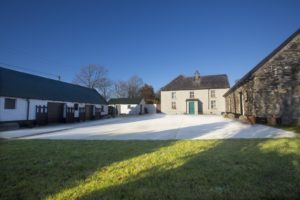
Travelling through the long string of history that erupts through generations of Kennedy’s, the exhibition gives a unique experience to the visitor seeking a sense of travelling through time with presidential descendancy. It enables a real life experience of a family’s story from time through famine immigrancy, to becoming the President of the United States.
The centre offers visitors to relive the moments that saw the president’s iconic return to the south-east of Ireland in 1963. From the sights and sounds of the president’s visit to the footage that followed, the experience is like no other and gives a true reflection of the visit. The centre also holds a souvenir shop and coffee dock for the visitors to recuperate after a tour around the establishment and its wealth of history.
Wexford has unique Irish American links being the ancestral home to President John F. Kennedy. Visitors can explore this connection through the emigrant trail, visiting the Kennedy Homestead, the JFK Arboretum and the Emigrant Flame and Dunbrody Famine Ship, a replica of the famine ship which his great-grandfather left Ireland aboard.
Check out more about The Kennedy Homestead
South of Wexford
Dunbrody Abbey

Like Tintern Abbey, Dunbrody Abbey was one of the many religious houses that were dismissed by Henry VIII between 1536 and 1541, and is a wonderful example of a 12th Century Cistercian Monastery. Founded in 1170 after the Norman invasion of Ireland, and completed around 1220, the lands surrounding the Abbey became a grant of Herve de Montmorency, to the monks of Bildewas in Shropshire. This was only if the monks built the Abbey, and ensured there was a sanctuary for all malefactors. As the first Abbot of Dunbrody, De Montmorency was buried in the Abbey, and thereafter it followed and flourished through time, with Thomas Herlyn, a monk of Tintern becoming imprisoned in the Abbey. Over the centuries, other issues arose, with the last Abbot of Dunbrody, Alexander Devereux, granting the Abbey and all its possessions to the King in 1542. Devereux changed religion and subsequently became the Bishop of Ferns.
The Etchingham family then became in possession of the Abbey and its surrounding lands, which saw heiress Jane Etchingham marry the second Earl of Donegall. To this very day, the Chichester family, the descendants of the second Earl, own the lands after it was handed over to the family in 1911 by the Office of Public Works.
From a variety of amenities on-site such as the Abbey itself, a maze with pitch and putt, a craft shop and tea rooms, Dunbrody Abbey is a forceful figure in County Wexford’s history. Make a trip to Dunbrody Abbey’s Visitor Centre and give way to heed of ancient stories through the times.
Check out more about Dunbrody Abbey
Hook Lighthouse
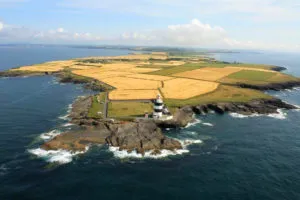
After being built in the 5th century, and standing at one of the world’s oldest lighthouses still operating, Hook Lighthouse is listed as one of the top 14 attractions in Ireland by the Lonely Planet, and rightly so. Originally, locals would light a fire to warn incoming mariners, until the early 1200s when William Marshall, a brother in law of Strongbow, built the tower as he had already set up a port in New Ross and needed the guide. A group of monks from a nearby monastery were the first custodians of the lighthouse and while they aided the construction of the lighthouse, they are also believed to have warned the sailors about the danger of the Hook peninsula by lighting beacons of fire.
With visitors marching each and every one of the tower’s 115 steps to indulge in the history of the lighthouse through time, it’s certainly an experience worth looking into. Take a tour of the tower and meet the life-size hologram of monk, St. Dubhán, who tells the tale of the nights spent in the lighthouse during the 5th century as they lit beacons of fire to stray the sailors from dangers. Endeavour to the second floor of the lighthouse to meet Knight William Marshal, a life-size figure telling his story about his journey to build Kilkenny Castle and Tintern Abbey, as well as the Hook Lighthouse in the 13th century which gave guide to his port’s shipping excursions.
Lastly, make it to the third floor and meet the tales of the lighthouse keeper as you reach the balcony and hit the airy sea breeze with the panoramic views of Wexford’s breathtaking coastline, and a 360 view of the sunny south-east.
Check out more about Hook Head Lighthouse
And to wrap up our #TravelTuesday post this week, enlightening and educating fellow Wexfordians, and those raring to visit and even more so intrigued by County Wexford’s history, we want to ask, which historical attraction are you most intrigued by, and which do you plan to visit when you #VisitWexford?
Have you got any facts about Wexford’s history that you’d like to share with us?
Plan ahead at VisitWexford.ie
#KeepDiscovering #IrelandsAncientEast
 Today
Today  Tomorrow
Tomorrow 
